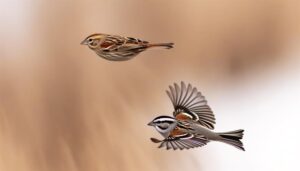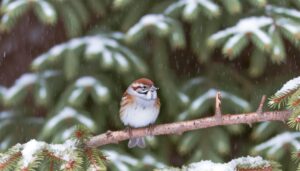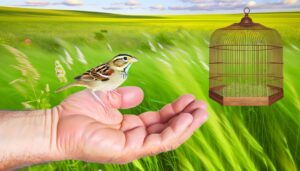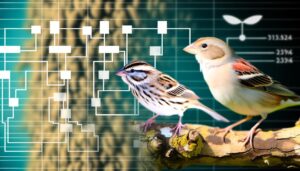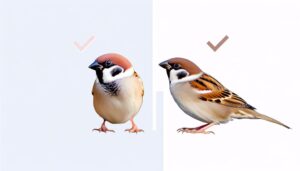5 Key Differences Between Chipping Sparrow and Pine Siskin
Chipping Sparrows, recognized for their russet cap and gray breast, thrive in various North American environments and follow a mainly seed-based diet. They're known for behaviors such as the 'double-scratch' foraging method and male aerial courtship dances.
Pine Siskins, on the other hand, have different breeding patterns, timing mating with abundant food. They favor coniferous and mixed forests for habitats, migrating based on food and weather.
Feeding mainly on conifer seeds, they exhibit adaptability to diverse environments. An exploration of their unique behaviors and habitat preferences can provide a deeper understanding of these distinct bird species.
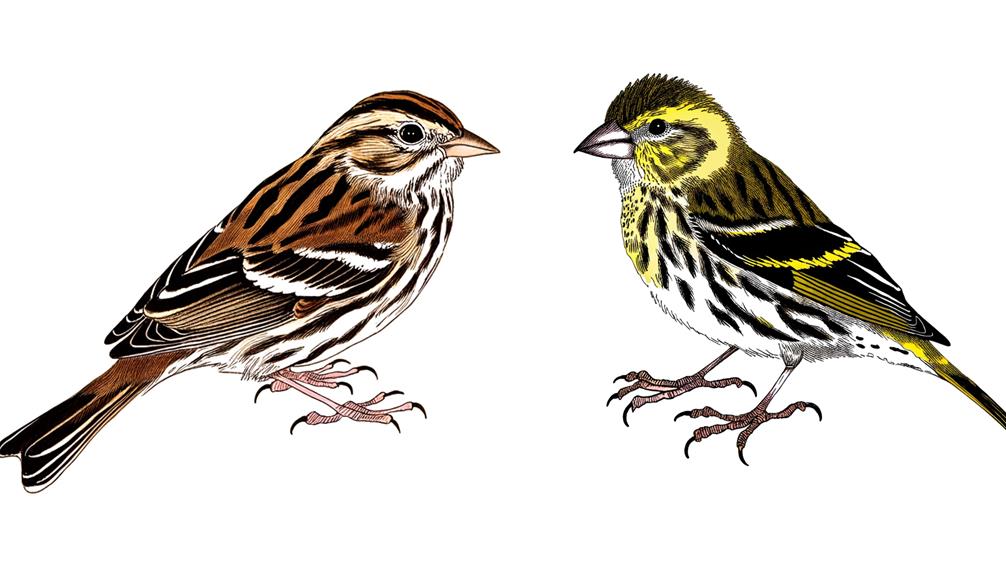
Key Takeaways
- Chipping Sparrows are recognized by their russet cap and gray breast, while Pine Siskins have densely streaked bodies.
- Chipping Sparrows prefer open woodlands and fields, whereas Pine Siskins thrive in boreal forests and regions with coniferous trees.
- Chipping Sparrows primarily feed on seeds, fruits, and insects, while Pine Siskins mainly consume seeds from coniferous and deciduous trees.
- Pine Siskins are opportunistic breeders, timing mating with food abundance, while Chipping Sparrows perform aerial dances for courtship.
- Chipping Sparrows migrate to southern US and Mexico in winter, while Pine Siskins exhibit unpredictable migration patterns based on food availability.
Chipping Sparrow Overview
Renowned for its vibrant russet cap and unmarked, crisp gray breast, the Chipping Sparrow is a small songbird that exhibits fascinating adaptability across diverse environments. This species, scientifically known as Spizella passerina, can be found across North America, ranging from the northern reaches of Canada to the southern edges of Mexico.
It's their unique adaptability that allows them to thrive in a variety of habitats, including open woodlands, parks, gardens, and suburban areas. During the breeding season, they're often seen in coniferous forests, showcasing another layer of their versatile nature.
The diet of the Chipping Sparrow mainly consists of seeds and insects, demonstrating an omnivorous feeding behavior which further contributes to their resilience in various ecological settings.
Recognizing Chipping Sparrow Appearance
Spotting a Chipping Sparrow isn't too tricky once you're familiar with its distinctive physical characteristics, which include a sharp, conical beak, a bright, russet-colored crown, and a clear, gray chest devoid of any markings. The species exhibits sexual monomorphism, meaning males and females alike share these features.
Their backs are streaked with black and brown, which provides camouflage among trees and shrubs. The bird's eyes are dark and alert, hinting at the sparrow's keen sense of its environment. Its small size, typically around 5 to 6 inches, combined with its slender and agile body, aids in quick and efficient foraging. The tail is relatively long and squared at the end, providing balance during flight.
Understanding Chipping Sparrow Behavior
Chipping Sparrows exhibit a fascinating array of behaviors that serve as key identifiers of the species, including their unique foraging strategies, social interactions, and flight patterns.
Foraging mainly on the ground, they use a 'double-scratch' method to uncover seeds and insects, a technique that involves a quick hop forward and backward.
Socially, they're known for their communal nature, often forming large mixed-species flocks outside of the breeding season.
Their flight pattern, characterized by a series of rapid wing beats followed by a short glide, is distinct and identifiable.
Males also display a courting behavior, performing an aerial dance to attract a mate. Understanding these behaviors can aid in distinguishing Chipping Sparrows from similar small bird species.
Chipping Sparrow Habitat and Distribution
Regarding habitat and distribution, Chipping Sparrows are found across a wide range, with a predilection for open woodlands, fields, parks, and gardens. These birds aren't limited to a specific geographic location, but instead, they're widespread across North America, from Alaska to Newfoundland and southwards to Florida and Mexico.
They're highly adaptable and capable of thriving in various environments, including both rural and urban areas. The only necessity seems to be the presence of sparse vegetation, which they use for nesting and foraging.
In the colder months, Chipping Sparrows migrate to the southern United States and Mexico, returning to their northern territories in the spring. This migratory pattern guarantees their survival during harsh winter conditions.
Feeding Habits of Chipping Sparrow
When it comes to their diet, Chipping Sparrows primarily feed on seeds, particularly those of grasses and weeds, but they'll also supplement their meals with small fruits and insects during the breeding season. This avian species shows a marked preference for the seeds of deciduous plants.
Their feeding habits shift seasonally, with a higher intake of animal matter, specifically arthropods, during the warmer months. This behavior is directly linked to their reproductive activities, as protein-rich insects are essential for the growth and development of their young.
Additionally, they've been observed foraging on the ground, meticulously searching for food amongst the foliage. Understanding these feeding habits is vital for conservation efforts, as it influences habitat management strategies.
Pine Siskin Overview
A small yet resilient bird, the Pine Siskin is characterized by its sharp, pointed bill and short, notched tail, making it a distinctive species in the finch family. It thrives in a wide range of environments, from the frigid boreal forests of Canada to the subtropical regions of Mexico.
This bird exhibits a high degree of adaptability, often flocking in large numbers during winter, seeking food sources far and wide.
Key characteristics of the Pine Siskin include:
- *Nomadic behavior:* They don't adhere to a fixed migration pattern, moving instead in response to food availability.
- *Social nature:* They often form large, noisy flocks.
- *Distinctive call:* Their voice is a rapid series of harsh, buzzy notes, unique among finches.
Distinguishing Pine Siskin Features
Identifying a Pine Siskin can be quite straightforward due to its distinctive physical attributes. A small songbird of the finch family, it typically measures 11-14 cm in length, with a wingspan of 18-22 cm. Its plumage is primarily brown with conspicuous streaks and yellow edging on the wings and tail, which is more visible in flight.
The beak is pointed and slender, perfect for extracting seeds from conifers, a staple in their diet. This bird's compact, robust body and notched tail further distinguish it from similar species. Its eyes are dark, adding to its unique appearance.
These precise physical details can aid birdwatchers, ornithologists, and nature enthusiasts in accurately distinguishing the Pine Siskin from other birds, particularly the Chipping Sparrow.
Behavioral Traits of Pine Siskin
In understanding the behavioral traits of the Pine Siskin, three key areas warrant specific attention: feeding habits, social interaction patterns, and nesting and breeding behaviors.
The bird's distinct feeding habits offer insight into its diet, foraging strategies, and adaptability to various food sources.
Moreover, an analysis of the Pine Siskin's social interactions and nesting/breeding patterns provides a detailed view of its lifestyle, social structure, and reproductive strategies.
Pine Siskin Feeding Habits
While observing the Pine Siskin, you'll notice that they've developed a preference for small, soft seeds, often feeding in flocks and demonstrating a remarkable adaptability to varied food sources. These birds are known for their ability to exploit a wide range of seed types, thanks to their specialized beak and tongue structure.
- They've been observed feeding on seeds from a variety of coniferous trees, including spruce, pine, and cedar.
- Pine Siskins also enjoy thistle and dandelion seeds, demonstrating a broad dietary spectrum.
- Their feeding behavior changes with the seasons, with a shift towards feeding on buds and catkins in the spring.
Social Interaction Traits
Often social by nature, Pine Siskins display a host of intriguing behavioral traits that enhance their interactions within their flock.
Their social nature becomes particularly apparent during feeding, with Pine Siskins often congregating in large numbers at feeders or on the ground. They are known to engage in social feeding, a behavior wherein one bird's feeding activity stimulates others to feed.
| Behavior | Description |
|---|---|
| Flocking | Pine Siskins often congregate in large numbers, demonstrating their social tendencies. |
| Social Feeding | They engage in communal feeding, stimulated by the activity of others. |
| Communication | They communicate using a variety of calls and songs. |
| Aggression | They can be aggressive, particularly during feeding times. |
| Play | Juveniles are observed to engage in playful behavior. |
Pine Siskins exhibit a fascinating blend of social and individual behaviors, further distinguishing them from other species such as the Chipping Sparrow.
Nesting and Breeding Patterns
Pine Siskins showcase distinct nesting and breeding patterns that set them apart in the avian world. These birds are known to be opportunistic breeders, timing their mating to coincide with abundant food resources.
The following points elucidate the unique breeding and nesting habits of Pine Siskins in a more detailed manner:
- Pine Siskins construct their nests in dense vegetation, typically coniferous trees, to conceal them from predators.
- The female is responsible for the incubation of the eggs, which lasts for about two weeks, while the male brings food.
- The young are born altricial, meaning they're helpless at birth and require intensive parental care.
Understanding these patterns can provide valuable insights into the behavioral traits of Pine Siskins, enhancing our knowledge of avian biodiversity.
Pine Siskin Habitat and Range
The Pine Siskin spans across North America, with a particular concentration in the boreal forests and mountainous regions. Its preferred habitat consists of coniferous and mixed forests, showing a notable affinity for areas abundant in spruce and pine.
The species exhibits distinct seasonal migration patterns, often moving southwards during harsh winter months, yet the extent of this movement can fluctuate based on food availability.
Pine Siskin Geographic Distribution
Where in the world can one find the Pine Siskin, you might wonder? These small, finch-like birds have a remarkably widespread geographic distribution. They can be seen throughout large parts of North America, including the United States and Canada. Notably, their range also extends into Central America, particularly areas of Mexico.
In a broader context, Pine Siskins have been observed in:
- The boreal forests and mountainous regions of Alaska and Canada
- A wide range of states across the US, from coastal and central regions to the southern states
- Central Mexico, with occasional sightings further south
It's important to note that while Pine Siskins are quite adaptable, their presence in these regions can fluctuate based on food availability and weather conditions.
Preferred Habitat Characteristics
When it comes to their preferred habitats, Pine Siskins are typically found in areas abundant with coniferous and deciduous trees. These environments offer ample food resources and nesting sites. While they're not strictly forest dwellers, they show a marked preference for mixed forests, especially those with spruce, pine, and cedar trees. This preference is largely due to the availability of their primary food source, seeds from these trees.
Geographically, their habitat range extends across North America, from Alaska to the northern parts of Mexico. Elevationally, they're typically found at middle to high altitudes. However, their adaptability allows them to inhabit a variety of environments, including suburban and urban areas, provided there's sufficient tree cover and food availability.
Seasonal Migration Patterns
Beyond their preference for densely wooded environments, Pine Siskins exhibit intriguing seasonal migration patterns. These small finches, known for their strong nomadic tendencies, unpredictably migrate in response to food availability. This irregular movement, known as irruption, allows them to explore a larger range beyond their typical northern habitats.
Pine Siskins mainly breed in the boreal forests of Canada and Alaska, extending to northern United States.
During winters, Pine Siskins can migrate southwards, often reaching as far as Mexico. However, if food is plentiful in the north, they may choose not to migrate.
These birds display a resilient adaptability to varied habitats, ranging from suburban backyards to remote coniferous forests.
Through this unpredictable pattern, Pine Siskins display an intriguing strategy to survive in changing environmental conditions.
Pine Siskin Diet and Feeding
Pine Siskins primarily feast on a wide variety of seeds and plant matter, showcasing a particular affinity for the seeds of conifers, alders, and birches. They're expert foragers, using their sharp, pointed beaks to extract seeds from cones with dexterity.
Siskins are also known to consume thistle and sunflower seeds, showing a proclivity for visiting backyard feeders. Their diet is complemented by small insects and spiders, adding a necessary protein component.
During winter months, when plant matter is scarce, Pine Siskins demonstrate a remarkable adaptability by seeking alternative food sources, such as tree buds and weed seeds. This flexibility in their diet allows them to survive in diverse habitats, highlighting the Pine Siskin's resilience and versatility.
Conclusion
To sum it up, the Chipping Sparrow's unique plumage, preference for feeding on the ground, and fondness for open woodlands sharply contrast the Pine Siskin's striped look, nimble flight, and preference for pine forests.
Despite both enjoying seeds, their feeding strategies are as distinct as can be.
This intriguing comparison takes us back to a time when the diverse beauty of nature was the main source of entertainment, serving as a vivid reminder of the stunning range of biodiversity that we should value.

